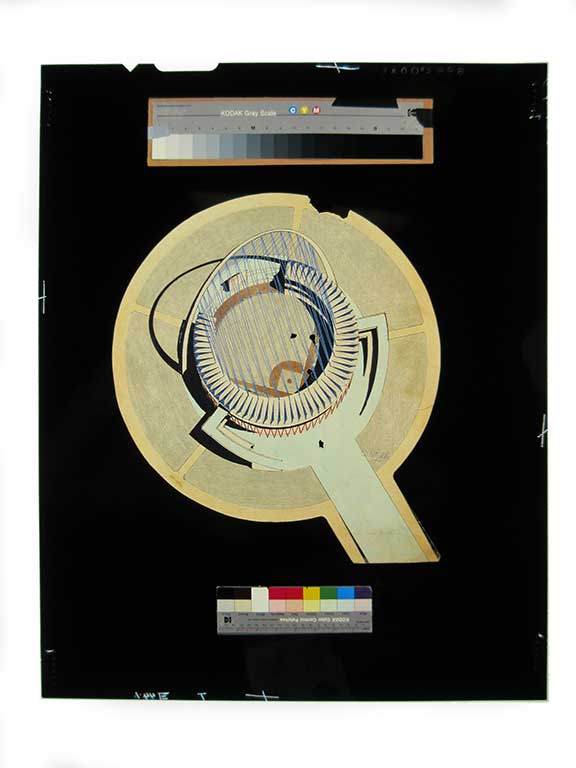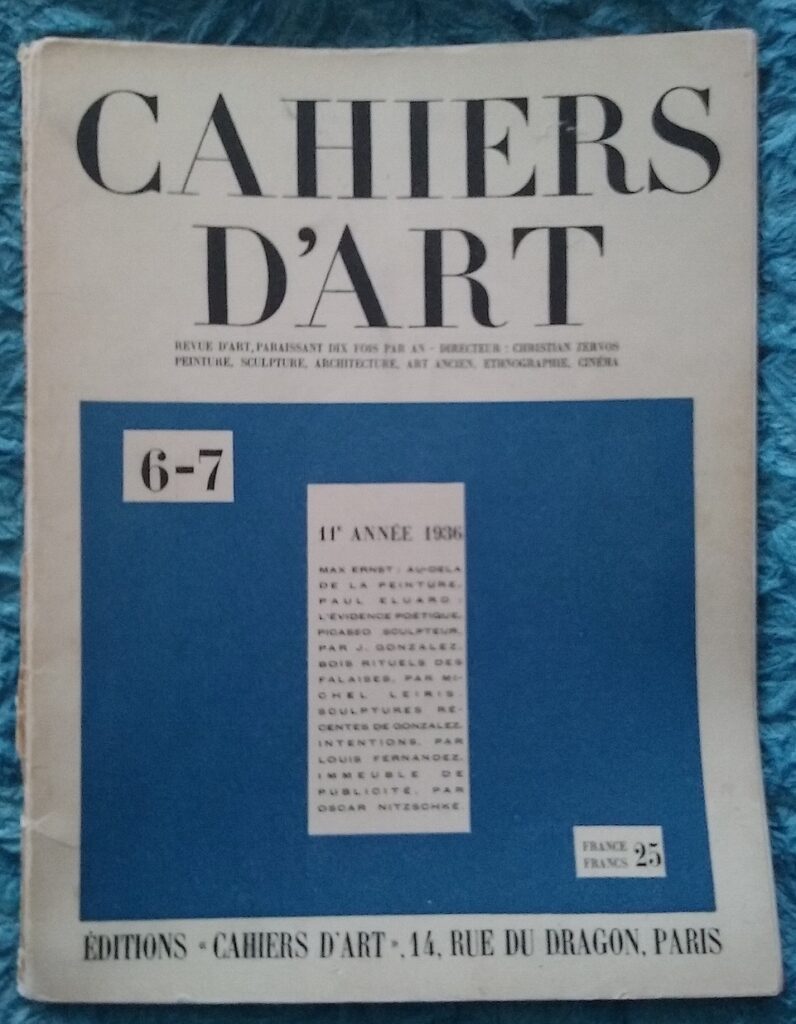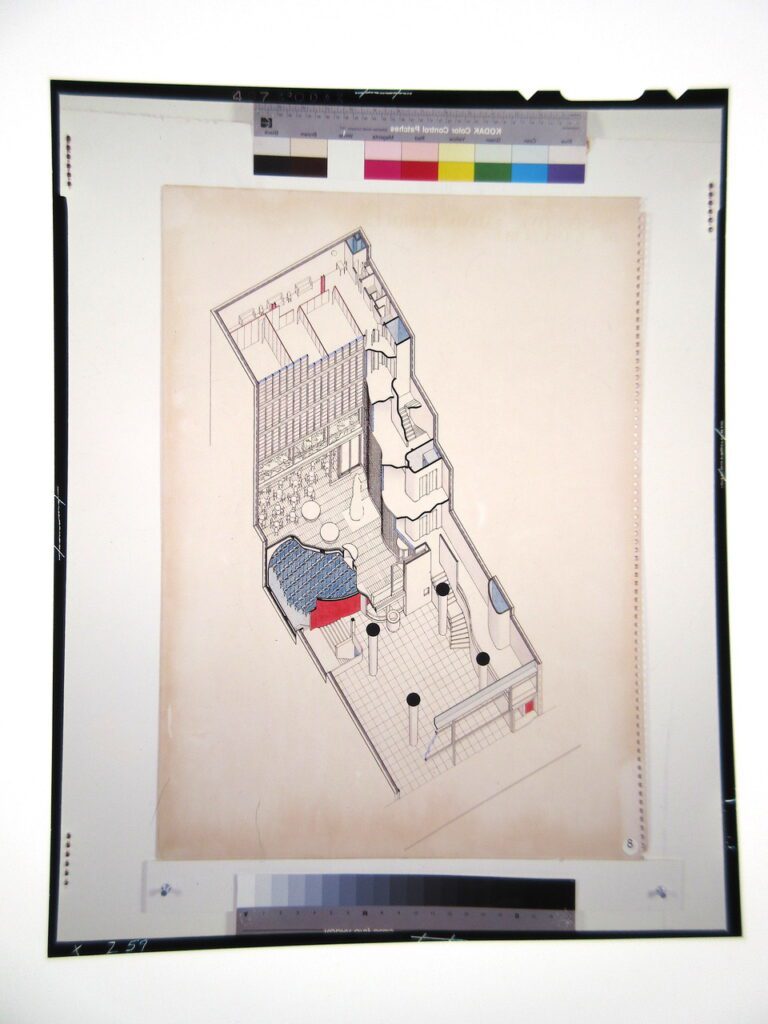Lea Lee
Oscar Nitzchke was a modernist architect, friend and associate of pre-and post-World War II era artists whose work he influenced, and whose architecture was influenced by those sculptors and painters. His 1936 drawings for his unrealized La Maison de la Publicité, projected for the Champs Elysees in 1935 are now part of MOMA’s permanent collection. In describing Nitzchke’s friend and associate’s project, Chareau’s Maison de Verre, completed in 1932, Kenneth Frampton, architectural art historian and Emeritus Professor of Architecture at Columbia University wrote that “Chareu’s Maison de Verre synthesizes the most diverse avantgardist trends of his time into the form of a new and generalizable architectural paradigm.” Then, crediting Nitzchke: “The genealogy of this work and the specific significance of its form are still, in my view, insufficiently known and understood, even today, although the image of Nitzchke’s cutaway axonometric is all too familiar to the cognoscenti of the thirties.” (Kenneth Frampton, “Oscar Nitzchke and the Ecole de Paris” published in Oscar Nitzchke Architect © The Cooper Union). His granddaughter Lea Lee, a visual artist who signed some of her photographs Eléonore Nitzschke in tribute to her grandfather’s works and life, recalls when, in 1975, she shared with her grandfather her desire to become a photographer. With a big smile, Oscar Nitzchke advised her to read Bouddhisme Zen in the Art of Archery. In this issue, Lea Lee is proud to share the magical, unusual, and forgotten stories from Oscar Nitzchke’s life as a brilliant but largely overlooked architect and intimate friend to many important 20th century artists, positioning him to become one of the greatest witnesses to modern Art history.

Born in 1900 in Altona (Germany) Nitzchke was admitted in 1917 to the Geneva Beaux Art in the class with Alberto Giacometti where he trained in drawing with Camoletti. Leaving Geneva, for Paris in 1920, Oscar Nitzchke related “I came to Paris, September 1920, with my mother because my family, my brothers, and sisters, were scared; you see I was the little one, and they were afraid to see me going alone to Paris. Because at that time Paris was known as the Ville Lumière, the ‘City of Light”. My mother stayed for three weeks. I had come from a little provincial area in Geneva. I did not know anything about Modern Art. In Geneva I had only once seen a watercolor exhibit by Cezanne. I joined Laloux-Lemarewquier studio, a pillar of academic teaching at the École des Beaux-Arts in Paris, Then it was, I think in 1923, that we came across a book by Le Corbusier, Vers Une Architecture, also L’Esprit Nouveau of Ozenfant and Jeanneret. After I passed by Gallery Jeanne Bucher Carrefour de la Croix Rouge in Paris, and saw on display a painting, I stayed fifteen minutes, fascinated and at the same time not understanding, and finally went in and asked the lady, ‘What is this? ‘Un Georges Braque, Monsieur.’ First time I heard of him.” Discovering the avant-garde, he left the studio that year, 1923 with a group of young rebels to open the Palais de Bois studio under Auguste Perret. In the company of Paul Nelson, Pierre Forestier, Ernö Goldfinger and Berthold Lubetkin, Nitzchké explored the potentialities of Perret’s rationalist constructive logic.
During his strolls through 1920’s Paris, he admired the work of Max Ernst and of the painter, Jean Dubuffet. His footsteps often led him from the Café de Flore in St. Germain-des-Près to Montparnasse where Kiki de Montparnasse, Man Ray, Modigliani, Alberto Giacometti, Pablo Picasso, André Breton, and many others rubbed shoulders. He also encountered painters Picasso, André Derain and Georges Braque in Varangeville and met with musicians, poets and filmmakers. In 1922 during the creation of Auguste Perret’s Palais de Bois movement, of which he was a part, he crossed paths with Darius Milhaud, Eric Satie, and Jean Prouvé. Oscar Nitzchke’s work was also influenced by other artistic movements extant in Europe at that time; Bauhaus, Constructivism, Dada, Surrealism, Cubism and Art Deco. As well, artists and architects including Sonia and Robert Delaunay, Paul Nelson and Pierre Chareau, and designers Emile Jacques Ruhlmann, Eileen Gray, Jean Michel Franck, Gustave Klimt, Toyen, and Tamara de Lempicka, and illustrators including Cassandre and Paul Colin influenced him. Oscar also discovered, with passion, the jazz of the interwar period, especially the music of Fats Waller. In his youth, he loved to laugh, go out and dance, frequented the Bal Nègre, and was fascinated by shows of artist Josephine Baker. Nitzchke narrates, “I can tell the story, how I met Christian Zervos and all these great characters. In 1928, with two friends from Atelier Perret, we had two first prizes for ‘Maisons Mettaliques’ for the Forges de Strasbourg. And this man, Zervos, who created Cahiers d’Art, the first magazine for modern art saw one of the houses. So he wrote us a letter – he would see the houses – and then he came to see the houses, and we became friends, I went to see him at his gallery. He had a famous gallery on rue du Dragon, in Saint Germain des Prés in the left bank in Paris. Then later, I met through him, Picasso, Braque, Leger, Ozenfant, Mirô, and many others.” This effervescence of turn-of-the-century contemporary art communicated with the architecture of the time, where 19th-century art was juxtaposed with avant-garde art.


Nitzchke’s mastery of contemporary architectural techniques earned him the prize of the 1929 Metal House competition organized by the Forges de Strasbourg, a city where he contributed to the creation of the Aubette dance hall with Theo Van Doesburg and the Arps. He built more than five hundred examples of his elegant sheet steel box and, introduced by Zervos, met the publicist Martial, owner of a plot of land on the Champs Élysées leading to Nitzchke’s design for the Maison de la Publicité in 1934-1936. Calling this “a founding project of a radically new approach to the relationship between visual communication and architecture … Forty years before the design of the Centre Georges-Pompidou, Nitzchke made the concrete building he imagined the support of a wall of moving images facing the avenue. A billboard by day and a luminous newspaper by night, this skin encompasses exhibition and audition rooms with fluid contours.” (Paul Nelson) Solicited by the painter Amédée Ozenfant, who commissioned him to design a project for his London school, Nitzchke then worked with Paul Nelson and Frantz-Philippe Jourdain on a Palais de la Découverte, whose organic forms and roofs suspended from cables inaugurated a repertoire far removed from the orthogonality of the ‘sovereign portico’ dear to Perret .
In 1936, on his first trip to New York, Oscar Nitzchke and his wife Ritou (Renée Nitzschke) met Alexander Calder and his wife Louisa. They became close friends, remaining friends for their entire lives, resulting in meeting with Paul Nelson in that year. The marvelous result of Alexander Calder’s and Oscar Nitzchke’s collaboration with Paul Nelson is La Maison Suspendue with its magnificent Calder and Arp sculptures, plus the marvelous Mirô contribution. Oscar’s perspective drawings for the Palais de la Decouverte, now in MOMA’s collection, resulted from Paul Nelson’s, Oscar Nitzchke’s and his colleague Frantz Jourdain’s commission to produce a study for a permanent science Museum in the city. “The project, unfortunately never realized, envisioned a structure that was as functional as it was monumental, the outer envelope being designed to contain diverse exhibits with quite different spatial needs.”

Oscar Nitzchke was invited, two years later in 1938, by Wallace K. Harrison, architect of Rockefeller Center, to work with him and teach at Yale University in New Haven. Leaving France for America, under the threat of invading Naziism in 1939 -1940, Oscar’s first collaboration in the United States, commissioned by Wallace Harrison, was helping Fernand Léger redecorate Rockefeller’s apartments in New York, where Fernand Leger had created his magnificent frescoes. As 1938 progressed, he was invited by Wallace K. Harrison, architect of Rockefeller Center, to work with him and teach at Yale University. Oscar then imagined buildings for the Bronx Zoo and, later, more austere skyscrapers for the United Nations Headquarters (1947), where he played a key role in the team developing the final project. Between 1949 and 1953, Nitzchke directed for Harrison and Max Abramovitz the construction elements, lobby and façade of the Alcoa headquarters in Pittsburgh. Hailed by Marcel Lods as the first classic of metal architecture, this thirty-story skyscraper creates, with the resources of pressed aluminum, a play of light and shadow hitherto missing from American curtain walls. In 1939-1940, Oscar imagined a new plan for the Bronx Zoo, very special and unusual, because the animals walked freely, not caged, unlike people watching them, who were inside a large transparent tube. In this project, Oscar collaborated with Alexander Calder adding Calder’s magnificent sculptures created in 1939-1940 for the adjacent African Habitat buildings at the Bronx Zoo designed by Oscar Nitzchke. As related by Paul Nelson, “The reaction to this project created a bit of a scandalous atmosphere. Oscar told me how much fun he had with Calder and how they laughed a lot while doing this project together to see the offended reaction of the right and strict thinking of New York’s bourgeoisie at that time. What would they think of the elevator tubes of Paris’ Georges Pompidou Center by Piano and Renzo, which take their audience into the paradise of the Georges Pompidou Museum, surely a nod to Nitzchke’s avant-garde project of 1939 that allowed animals freedom while humans had to contemplate them with wonder, while being enclosed in a transparent Tube?”

Not only did Oscar Nitzchke bring Alexander Calder to Yale, making jokes with Calder for
the students, who created a hanging mobile with socks, but Oscar also made possible the inclusion of a Calder Mobile in a monumental exhibition at Yale mounted by Henry Kibel in 1943.” On a more serious side, in 1958, Oscar Nitzchke again collaborated with Calder, and the architect Saul Edelbaum on an Auschwitz memorial in Israel. Oscar Nitzchke participated in many, major architectural projects where his name has been forgotten, such as his collaboration with Pierre Chareau to redesign Robert Motherwell’s East Hampton house in 1947, where, as Lea Lee relates: “My grandfather said to me with a big laugh, “Robert Motherwell didn’t have any money at that time to pay our fee with Pierre Chareau so Motherwell gave us a Picasso drawing that we immediately sold, and we ate and drank off it together.”
At the same time, Oscar Nitzchke was working on the austere skyscrapers for the United Nations Headquarters as one of the international team of fourteen architects who designed the United Nations Headquarters under Wallace Harrison’s leadership. He contributed ideas and drawings; his professional abilities and his personality helped facilitate the cooperative effort of many strong, and often contentious personalities. Oscar and his friend, architect George Dudley, had worked with Harrison in his firm and at Yale. He was also acquainted with architects, especially Le Corbusier, who he had known since 1922 in Paris. George Dudley had acted as the recording secretary of the UN design process, and later wrote a book based on his notes and further research, Workshop for Peace–Designing the United Nations Headquarters. In his memories about the UN project, Oscar Nitzchke wrote:
“One evening the others were gone, and I was alone with Corbusier, and there was his model and Oscar Niemeyer’s model. And then, he asked me, ‘Which one do you like better?’ I said I liked Niemeyer’s; I like the plans, and I like the sculpture in the middle, and all that I said, it looked more Greek to me; then he said, ‘As you know, Oscar, Niemeyer is a wonderful artist, but not so much an architect’. Corbusier was fantastic, how he drew. I mean, he made sketches without hesitation, he was so sure. He was a genius. No doubt I mean impossible genius.”
“Le Corbusier’s letters from the time describe a less than harmonious working atmosphere. ‘I’m working here with Harrison, an American who’s a fraction jealous, and fourteen architects from different nations, he wrote to his mother on 6 May 1947. ‘⅓ hostile, ⅔ in favor. The draftsmen have become my friends. We can do something magnificent, and that’s why I forge on.’ Officially, the building’s design is credited to the committee –which included Le Corbusier – though many say that the completed complex more closely resembled the designs submitted by the Brazilian architect Oscar Niemeyer.” In New York, Oscar became enthusiastic about the first historical exhibition at the Denise René Gallery. With the patronage of Alexander Calder, a pioneering kinetic artist with his moving works of the 1930s and the participation of the young Yaacov Agam and Vasarely, this exhibition introduced the kinetic movement into post-war contemporary art and gave rise to kinetic movements created by South American artists who had taken refuge in 1950s and 60s Paris.
Oscar became good friends with Duke Ellington, Charlie Parker, Sarah Vaughan regularly frequenting the bars of Harlem, where jazz musicians performed, and Birdland on New York’s 47th Street. Oscar became a discreet messenger between Zervos, former publisher and friend from Paris, and Initiator of Picasso’s Catalogue Raissone, and American curators and museum directors, including MOMA’s in 1945. Always passionate about art, Oscar frequented the whole of New York at the time meeting at galleries, Pierre Matisse, Leo Castelli, Sidney Janis, Julien Levy, Klaus Perls, to name only the most famous.In the 1940s and 50s, good friends Elaine and Willem de Kooning frequented the Cedar Bar with Nitzchke, then the meeting point of many artists including Jackson Pollock, Franz Kline, Arshile Gorky and John Cage. All these people led a bohemian life and lived in joyful exchanges, bartering being customary, between two drinks and two giggles. The conversations were lively; they were dancing and singing.

© Eleonore Nitzschke
Nikolai Buglaï, a New York artist, writes in his interview article in Ragazine magazine, “Oscar Nitzchke is like a delicious slice of twentieth-century art. He was at the same table when Picasso and James Joyce met. He was Bûnuel’s roommate in Los Angeles when Bûnuel was a pauper. In Harlem, he knew Basie and Ellington, the whole group. He knew everybody. He used to drive around with Peggy Guggenheim in her pink Cadillac throughout the United States. So he had contact with the whole crew. In his pauper years, he would borrow money from Calder. Calder would give him little works of art that he could sell for money. From Satie he would get original manuscripts that he would turn into money. In that sense, he was an interesting guy. When his hearing got bad, people refused to hire him. But at age 80 or 83, his old students from Yale University got him a show at Cooper Union. Once he got the big show Cooper Union produced this fancy catalogue of his work. Nitzchke met Jean-Louis Cohen at the Eileen Gray Bard Museum exhibit in New York in March 2020, remembering being delighted to read in the exhibition catalogue that Eileen Gray herself had been influenced in 1936 by Oscar Nitzchke’s The House of Advertising. La Maison de la Publicité featured in an article published by Christian Zervos in the Cahiers d’Art in 1936. Lea Lee is sure that, somewhere, this makes Oscar smile.
Nitzchke’s active participation in an important historical process can be seen as it extends over a long professional life on two continents. He was an inspirer, a collaborator, an enthusiast, a communicator, a catalyst; constantly and intimately involved with three generations of many of the most influential shapers of the modern movement. (from Le Corbusier’s letters to his mother about his work during the UN © Phaidon © Jean Louis Cohen) Oscar’s friend and colleague, architect Georges Dudley wrote to Denise Scott and the Art critic/architect Robert Venturi. “The shift of themes and forms from modern European architecture to the United States has too often been seen as resulting solely from the exhibition The International Style, organized in 1932 at the Museum of Modern Art in New York by Henry-Russell Hitchcock and Philip Johnson. Those who passed on such as Oscar Nitzchké, however, allow us to discover the more secret itineraries by which a lasting transmission of the experiences of German or French modernism was accomplished.
Oscar Nitzschke. Alexander Calder portrait 1960 © Eleonore Nitzschke
